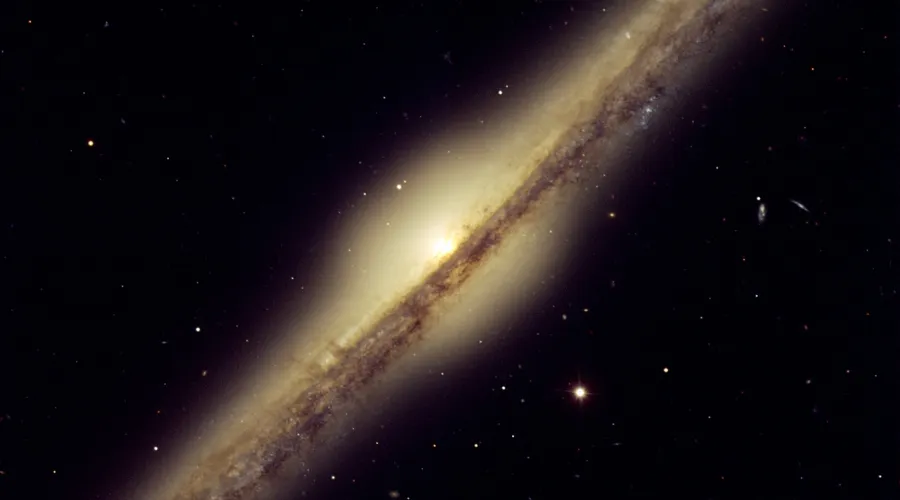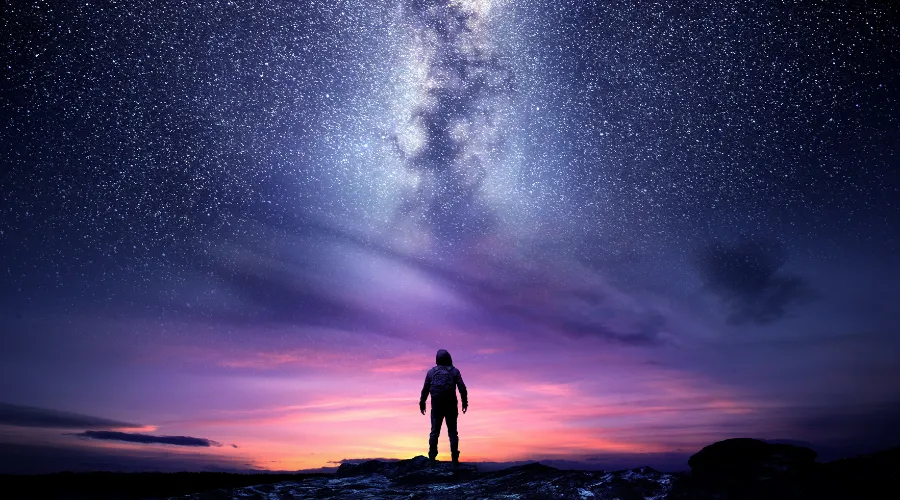Central Engine of the Milky Way: How the Supermassive Black Hole Shapes Our Galaxy

The central engine of the Milky Way, a supermassive black hole named Sagittarius A* (Sgr A*), is a cosmic titan orchestrating the galaxy’s intricate dance.
Anúncios
Located 26,000 light-years from Earth, this enigmatic object, with a mass 4.1 million times that of the Sun, exerts a gravitational pull that influences stars, gas clouds, and even the galaxy’s evolution.
But how does this invisible giant, cloaked in the heart of our galactic home, ripple through the cosmos?
This article dives into the dynamic role of Sgr A*, exploring its impact on stellar orbits, galactic structure, and cosmic phenomena, while weaving in fresh perspectives and cutting-edge insights.
The Heartbeat of the Galaxy
Picture a bustling metropolis with a single, unyielding force at its core, dictating the rhythm of everything around it.
That’s the central engine of the Milky Way, where Sgr A* resides, anchoring the galaxy’s core.
Unlike a city’s vibrant hub, this black hole is a region of spacetime so dense that not even light escapes its grasp.
Yet, its influence extends far beyond its event horizon, the point of no return.
Stars whip around it at breakneck speeds, some reaching velocities of 3 million miles per hour, their orbits sculpted by its immense gravity.
This gravitational choreography isn’t just a spectacle—it’s a clue to the black hole’s power.
In 2022, the Event Horizon Telescope (EHT) captured the first image of Sgr A*, revealing a glowing ring of superheated gas swirling around its shadow.
This milestone confirmed theories about its structure and sparked new questions about its role.
How does a single object, occupying a space no larger than our solar system, govern an entire galaxy spanning 100,000 light-years?
Recent studies suggest that the dynamics around Sgr A* may also influence the formation of new stars in the surrounding regions, further emphasizing its critical role in the galactic ecosystem.
Understanding these interactions is essential for unraveling the complexities of our galaxy’s structure.
Stellar Orbits: A Cosmic Ballet
The stars nearest to Sgr A* are like dancers in a high-stakes performance, their paths tightly choreographed by the central engine of the Milky Way.
Take the star S2, for example, which orbits Sgr A* every 16 years in a highly elliptical path.
Its closest approach, or periapsis, brings it within 17 light-hours of the black hole, where it experiences intense gravitational forces.
Observations of S2’s orbit, tracked over decades by teams at the Max Planck Institute, provided critical evidence for general relativity, showing how spacetime warps under extreme conditions.
This stellar ballet isn’t without drama.
Some stars, pushed too close by gravitational nudges from neighboring objects, may plunge toward Sgr A*, shredded into streams of gas in a process called tidal disruption.
These events release brilliant flares, briefly outshining entire star clusters.
For instance, in 2019, astronomers detected a flare from a star devoured by Sgr A*, offering a glimpse into the black hole’s feeding habits.
Such spectacles underscore the central engine’s role in regulating the dynamics of the galactic core.
| Star | Orbital Period (Years) | Closest Approach to Sgr A* (Light-Hours) | Velocity at Periapsis (km/s) |
|---|---|---|---|
| S2 | 16 | 17 | 7,600 |
| S62 | 9.9 | 2.4 | 10,000 |
Additionally, the study of these stellar orbits provides insights into the gravitational effects of Sgr A*, helping astronomers refine their models of black hole behavior and galactic dynamics.
This research continues to deepen our understanding of how supermassive black holes interact with their surroundings.
+ Supermassive Black Hole Emits Burst of Energy After Swallowing Gas: Understanding the Cosmic Hiccup
Gas Dynamics and Galactic Evolution
Beyond stars, the central engine of the Milky Way shapes vast clouds of gas and dust, the raw materials of star formation.
The galactic center is a turbulent zone, with gas spiraling inward under Sgr A*’s pull, heating up as it compresses.
This process fuels bursts of star formation, creating clusters of massive, short-lived stars that illuminate the core.
However, the black hole’s influence isn’t always constructive.
Its gravitational tides can disrupt gas clouds, preventing them from collapsing into stars, thus regulating the galaxy’s star-forming rhythm.
Consider the analogy of a cosmic chef: Sgr A* stirs the galactic pot, deciding when ingredients combine to form new stars or get flung into oblivion.
In 2023, a study published in Nature Astronomy revealed that the central engine’s feedback mechanisms—jets and radiation from accreting material—can suppress star formation within a 1,000-light-year radius.
This feedback shapes the galaxy’s structure, maintaining a delicate balance between creation and destruction.
Moreover, ongoing observations of gas dynamics around Sgr A* are crucial for understanding how supermassive black holes influence star formation across the universe.
These insights may help scientists predict the future evolution of galaxies.

Jets and Outflows: Galactic Sculptors
Supermassive black holes like Sgr A* aren’t just passive sinks; they’re active sculptors.
When material falls toward the central engine of the Milky Way, it forms an accretion disk, a swirling maelstrom of gas and dust.
Friction within this disk generates intense heat and magnetic fields, launching powerful jets of plasma at near-light speeds.
While Sgr A* is relatively quiescent compared to active galactic nuclei in other galaxies, evidence of past outbursts lingers.
Take the Fermi Bubbles, two colossal structures extending 25,000 light-years above and below the galactic plane.
Discovered in 2010 by NASA’s Fermi Gamma-ray Space Telescope, these bubbles are likely remnants of ancient jets powered by the central engine of the Milky Way.
They contain high-energy particles and magnetic fields, hinting at a time when Sgr A* was far more active, perhaps millions of years ago when it devoured a massive gas cloud.
These structures reshape the galactic environment, influencing gas distribution and magnetic fields across vast distances.
| Feature | Size (Light-Years) | Origin | Impact |
|---|---|---|---|
| Fermi Bubbles | 50,000 (total span) | Past Sgr A* activity | Alters galactic magnetic fields |
| Galactic Center Lobe | 1,000 | Recent accretion events | Influences local star formation |
The jets and outflows from Sgr A* also serve as a reminder of the dynamic processes at play in the galaxy, shaping not only the central region but also affecting star formation in the outer areas.
Future observations may reveal even more about these powerful jets and their long-term effects on galactic evolution.
Ripple Effect on Galactic Structure
The central engine of the Milky Way doesn’t just influence its immediate surroundings—it shapes the galaxy’s broader architecture.
The galactic bar, a dense, elongated structure of stars at the Milky Way’s core, owes its stability to Sgr A*’s gravity.
This bar funnels gas inward, feeding the black hole and fueling star formation, while its rotation influences the spiral arms’ structure.
Without the central engine’s anchoring force, the Milky Way’s spiral pattern might unravel, disrupting its iconic shape.
Imagine a cosmic clock, with Sgr A* as the mainspring, keeping the galaxy’s components ticking in harmony.
Disruptions to this balance, like a close encounter with another galaxy, could destabilize the bar or trigger a feeding frenzy for Sgr A*.
Such events, though rare, could transform the Milky Way’s structure over billions of years, potentially turning it into an elliptical galaxy.
Furthermore, understanding the interactions between Sgr A* and other galactic structures is vital for predicting the Milky Way’s future evolution.
These insights can help astronomers model potential scenarios for our galaxy’s long-term fate.
++ The Role of Infrared Light in Discovering Hidden Galaxies
Cosmic Context: Comparing Galactic Engines
To appreciate the central engine of the Milky Way, consider its cousins in other galaxies.
The supermassive black hole in Messier 87 (M87), imaged by the EHT in 2019, is 6.5 billion solar masses—over 1,500 times more massive than Sgr A.
Its jets dominate its galaxy, blasting material across intergalactic space.
Sgr A*, by contrast, is relatively sedate, with sporadic feeding and weaker jets.
This comparison highlights a key point: not all central engines are equal.
The Milky Way’s black hole is a subtle conductor, shaping its galaxy through steady influence rather than violent outbursts.
For example, the galaxy NGC 1277 hosts a black hole so massive it accounts for 14% of its host’s mass, dwarfing Sgr A*’s 0.01% share of the Milky Way’s mass.
This statistic underscores the diversity of black hole-galaxy relationships.
In the Milky Way, Sgr A*’s understated dominance allows for a stable, star-rich environment, fostering the conditions that made life on Earth possible.
Additionally, by studying other galaxies and their central engines, scientists can gain valuable insights into the processes that govern galaxy formation and evolution.
This comparative approach broadens our understanding of the universe.

The Future of the Central Engine
What lies ahead for the central engine of the Milky Way?
Sgr A*’s current quiescence may not last.
In about 4 billion years, the Milky Way will collide with the Andromeda galaxy, potentially awakening Sgr A*.
As gas clouds from both galaxies merge, the black hole could gorge, unleashing powerful jets and flares.
This cosmic merger might transform the central engine into a blazing beacon, visible across the universe.
Alternatively, Sgr A* could remain a quiet giant, slowly accreting material as the galaxy ages.
Upcoming observatories, like the James Webb Space Telescope and the Square Kilometre Array, will probe the galactic center with unprecedented detail, revealing how Sgr A*’s influence evolves.
Will it continue to shape the Milky Way with subtle precision, or will it erupt into a cosmic spectacle?
As astronomers prepare for these observations, they are eager to learn how Sgr A*’s behavior might change in response to galactic events.
These insights could significantly enhance our understanding of black hole dynamics.
For further reading and insights into the central engine of the Milky Way and its implications for our understanding of galaxies, visit NASA’s Jet Propulsion Laboratory.
Engaging the Cosmic Mystery
The central engine of the Milky Way is more than a scientific curiosity—it’s a testament to the universe’s complexity.
Its gravitational grip, subtle yet profound, weaves together stars, gas, and cosmic phenomena into a galactic tapestry.
By studying Sgr A*, we unravel the Milky Way’s past, present, and future, from its star-forming nurseries to its sprawling spiral arms.
Isn’t it awe-inspiring to think a single, invisible object holds such sway over our cosmic home?
Through precise observations, like those of S2’s orbit or the Fermi Bubbles’ glow, we glimpse the black hole’s far-reaching effects.
With each discovery, we inch closer to understanding how the central engine of the Milky Way sculpts the galaxy we call home, reminding us of our place in the vast, ever-evolving cosmos.
This resource provides valuable information about ongoing research and discoveries related to Sgr A*.
